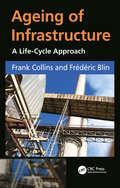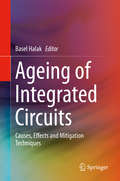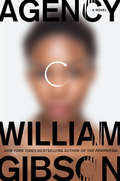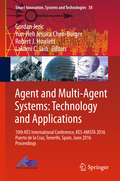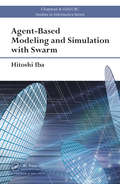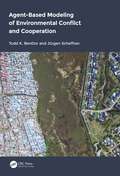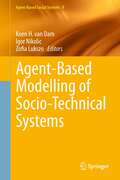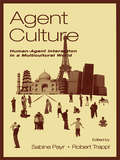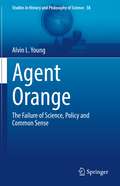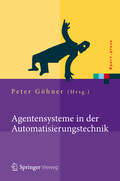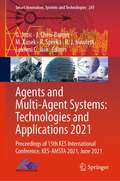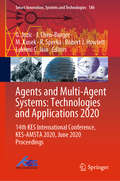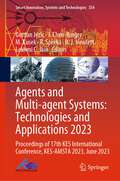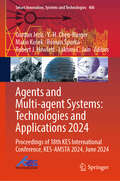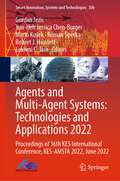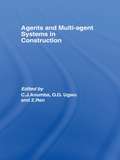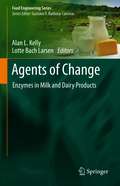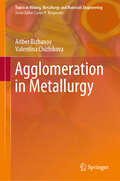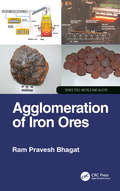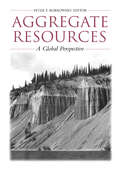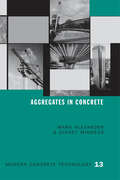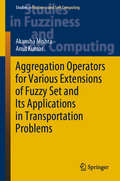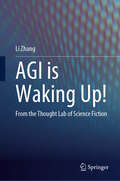- Table View
- List View
Ageing of Infrastructure: A Life-Cycle Approach
by Frank Collins Frédéric BlinThe book addresses the problem of ageing infrastructure and how ageing can reduce the service life below expected levels. The rate of ageing is affected by the type of construction material, environmental exposure, function of the infrastructure, and loading: each of these factors is considered in the assessment of ageing. How do international design codes address ageing? Predictive models of ageing behaviour are available and the different types (empirical, deterministic, and probabilistic) are discussed in a whole-of-life context. Life cycle plans, initiated at the design stage, can ensure that the design life is met, while optimising the management of the asset: reducing life cycle costs and reducing the environmental footprint due to less maintenance/remediation interventions and fewer unplanned stoppages and delays. Health monitoring of infrastructure can be conducted via implanted probes (wired or wireless) or by non-destructive testing that can routinely measure the durability, loading, and exposure environments at key locations around the facility. Routine monitoring can trigger preventative maintenance that can extend the life of the infrastructure and minimise unplanned and reactive remediation, while also providing ongoing data that can be utilised towards more durable future construction. Future infrastructure will need to be safe and durable, financially and environmentally sustainable over the lifecycle, thereby raising socio-economic wellbeing. The book concludes by discussing the key impacting factors that will need to be addressed. The author brings a strong academic and industry background to present a resource for academics and practitioners wishing to address the ageing of built infrastructure.
Ageing of Integrated Circuits: Causes, Effects and Mitigation Techniques
by Basel HalakThis book provides comprehensive coverage of the latest research into integrated circuits’ ageing, explaining the causes of this phenomenon, describing its effects on electronic systems, and providing mitigation techniques to build ageing-resilient circuits.
Agency: Public Agencies Under Fire (Urban Affairs Annual Reviews #15)
by William GibsonWilliam Gibson has trained his eye on the future for decades, ever since coining the term “cyberspace” and then popularizing it in his classic speculative novel Neuromancer in the early 1980s. Cory Doctorow raved that The Peripheral is “spectacular, a piece of trenchant, far-future speculation that features all the eyeball kicks of Neuromancer.” Now Gibson is back with Agency—a science fiction thriller heavily influenced by our most current events. <p><p> Verity Jane, gifted app whisperer, takes a job as the beta tester for a new product: a digital assistant, accessed through a pair of ordinary-looking glasses. “Eunice,” the disarmingly human AI in the glasses, manifests a face, a fragmentary past, and a canny grasp of combat strategy. Realizing that her cryptic new employers don’t yet know how powerful and valuable Eunice is, Verity instinctively decides that it’s best they don’t. <p> Meanwhile, a century ahead in London, in a different time line entirely, Wilf Netherton works amid plutocrats and plunderers, survivors of the slow and steady apocalypse known as the jackpot. His boss, the enigmatic Ainsley Lowbeer, can look into alternate pasts and nudge their ultimate directions. Verity and Eunice are her current project. Wilf can see what Verity and Eunice can’t: their own version of the jackpot, just around the corner, and the roles they both may play in it. <p> <b>A New York Times Bestseller</b>
Agent and Multi-Agent Systems: 10th KES International Conference, KES-AMSTA 2016 Puerto de la Cruz, Tenerife, Spain, June 2016 Proceedings (Smart Innovation, Systems and Technologies #58)
by Lakhmi C. Jain Robert J. Howlett Gordan Jezic Yun-Heh Jessica Chen-BurgerThe modern economy is driven by technologies and knowledge. Digital technologies can free, shift and multiply choices, often intruding on the space of other industries, by providing new ways of conducting business operations and creating values for customers and companies. The topics covered in this volume include software agents, multi-agent systems, agent modelling, mobile and cloud computing, big data analysis, business intelligence, artificial intelligence, social systems, computer embedded systems and nature inspired manufacturing, etc. that contribute to the modern Digital Economy. This volume highlights new trends and challenges in agent, new digital and knowledge economy research and includes 28 papers classified in the following specific topics: business process management, agent-based modeling and simulation, anthropic-oriented computing, learning paradigms, business informatics and gaming, digital economy, and advances in networked virtual enterprises. Published papers were selected for presentation at the 10th KES Conference on Agent and Multi-Agent Systems: Technologies and Applications (KES-AMSTA 2016) held in Puerto de la Cruz, Tenerife, Spain. Presented results would be of theoretical and practical value to researchers and industrial practitioners working in the fields of artificial intelligence, collective computational intelligence, innovative business models, new digital and knowledge economy and, in particular, agent and multi-agent systems, technologies, tools and applications.
Agent-Based Modeling and Simulation with Swarm (Chapman & Hall/CRC Studies in Informatics Series)
by Hitoshi IbaSwarm-based multi-agent simulation leads to better modeling of tasks in biology, engineering, economics, art, and many other areas. It also facilitates an understanding of complicated phenomena that cannot be solved analytically. Agent-Based Modeling and Simulation with Swarm provides the methodology for a multi-agent-based modeling approach that i
Agent-Based Modeling of Environmental Conflict and Cooperation
by Todd BenDor Jürgen ScheffranConflict is a major facet of many environmental challenges of our time. However, growing conflict complexity makes it more difficult to identify win-win strategies for sustainable conflict resolution. Innovative methods are needed to help predict, understand, and resolve conflicts in cooperative ways.Agent-Based Modeling of Environmental Conflict and Cooperation examines computer modeling techniques as an important set of tools for assessing environmental and resource-based conflicts and, ultimately, for finding pathways to conflict resolution and cooperation. This book has two major goals. First, it argues that complexity science can be a unifying framework for professions engaged in conflict studies and resolution, including anthropology, law, management, peace studies, urban planning, and geography. Second, this book presents an innovative framework for approaching conflicts as complex adaptive systems by using many forms of environmental analysis, including system dynamics modeling, agent-based modeling, evolutionary game theory, viability theory, and network analysis. Known as VIABLE (Values and Investments from Agent-Based interaction and Learning in Environmental systems), this framework allows users to model advanced facets of conflicts—including institution building, coalition formation, adaptive learning, and the potential for future conflict—and conflict resolution based on the long-term viability of the actors’ strategies.Written for scholars, students, practitioners, and policy makers alike, this book offers readers an extensive introduction to environmental conflict research and resolution techniques. As the result of decades of research, the text presents a strong argument for conflict modeling and reviews the most popular and advanced techniques, including system dynamics modeling, agent-based modeling, and participatory modeling methods. This indispensable guide uses NetLogo, a widely used and free modeling software package, to implement the VIABLE modeling approach in three case study applications around the world. Readers are invited to explore, adapt, modify, and expand these models to conflicts they hope to better understand and resolve.
Agent-Based Modelling of Socio-Technical Systems (Agent-Based Social Systems #9)
by Zofia Lukszo Koen H. Dam Igor NikolicDecision makers in large scale interconnected network systems require simulation models for decision support. The behaviour of these systems is determined by many actors, situated in a dynamic, multi-actor, multi-objective and multi-level environment. How can such systems be modelled and how can the socio-technical complexity be captured? Agent-based modelling is a proven approach to handle this challenge. This book provides a practical introduction to agent-based modelling of socio-technical systems, based on a methodology that has been developed at TU Delft and which has been deployed in a large number of case studies. The book consists of two parts: the first presents the background, theory and methodology as well as practical guidelines and procedures for building models. In the second part this theory is applied to a number of case studies, where for each model the development steps are presented extensively, preparing the reader for creating own models.
Agent Culture: Human-agent interaction in A Multicultural World
by Sabine Payr Robert TrapplThis volume began with a workshop of the Austrian Research Institute for Artificial Intelligence held in 2001. Concerned with embodied agents as cultural objects and subjects, the book is divided into three parts. It begins by drawing attention to the cultural embeddedness of technology in general and agent design in particular, as a reminder that
Agent Orange: The Failure of Science, Policy and Common Sense (Studies in History and Philosophy of Science #58)
by Alvin L. YoungThis book tells the story of Agent Orange, its usage and the policies that surround it. Agent Orange contains a contaminant known as TCDD. It was the most widely used defoliant from 1965 – 1970 and became one of three major tactical herbicides used in Vietnam. More than 45 major health studies were conducted with Vietnam veterans from the United States, Australia, New Zealand, and Korea seeking a relationship between veterans’ health and TCDD. Allegations of birth defects in the families of Vietnam veterans and the Vietnamese represented a case study in propaganda and deliberate misinformation by the government of Vietnam. The Policies of the US Government implemented by Congress and the Department of Veterans Affairs (DVA) identified 17 recognized associated presumptive diseases that failed the tests of “cause and effect” and common sense. This book tells the story of Agent Orange, its usage, the health studies and those policies from a diverse range of perspectives, delving into science, statistics, history, policy and ethics. It is of interest to scholars engaged in history, political and social philosophy and ethics.
Agentensysteme in der Automatisierungstechnik (Xpert.press)
by Peter GöhnerBei modernen automatisierten Systemen gewinnen Anforderungen an die Flexibilität (z. B. Anpassungsfähigkeit, Skalierbarkeit und Integrationsfähigkeit) zunehmend an Bedeutung. Vielfach ist jedoch noch unklar, wie die gewünschte Flexibilität bei der Entwicklung eines automatisierten Systems erzielt und die dadurch entstehenden komplexen Abläufe und Verhaltensweisen beherrscht werden können. Mit Hilfe von Softwareagenten wird es möglich, die notwendige Flexibilität von automatisierten Systemen systematisch zu entwerfen. Im GMA-Fachausschuss 5.15 "Agentensysteme" erarbeiten Fachleute aus Wissenschaft und Industrie Richtlinien zur Entwicklung und Anwendung von Agentensystemen in der Automatisierungstechnik. Im Rahmen dieser Arbeiten sind viele Beiträge zum Stand der Technik bzw. Stand der Wissenschaft von Agentensystemen in der Automatisierungstechnik entstanden, die in diesem Werk zusammengestellt wurden.
Agents and Multi-Agent Systems: Proceedings of 15th KES International Conference, KES-AMSTA 2021, June 2021 (Smart Innovation, Systems and Technologies #241)
by G. Jezic J. Chen-Burger M. Kusek R. Sperka R. J. Howlett Lakhmi C. JainThis book highlights new trends and challenges in research on agents and the new digital and knowledge economy. It includes papers on business process management, agent-based modeling and simulation, and anthropic-oriented computing that were originally presented at the 15th International KES Conference on Agents and Multi-Agent Systems: Technologies and Applications (KES-AMSTA 2021), being held as a Virtual Conference in June 14–16, 2021. The respective papers cover topics such as software agents, multi-agent systems, agent modeling, mobile and cloud computing, big data analysis, business intelligence, artificial intelligence, social systems, computer embedded systems, and nature-inspired manufacturing, all of which contribute to the modern digital economy.
Agents and Multi-Agent Systems: 14th KES International Conference, KES-AMSTA 2020, June 2020 Proceedings (Smart Innovation, Systems and Technologies #186)
by G. Jezic J. Chen-Burger M. Kusek R. Sperka Robert J. Howlett Lakhmi C. JainThe book highlights new trends and challenges in research on agents and the new digital and knowledge economy. It includes papers on business process management, agent-based modeling and simulation and anthropic-oriented computing that were originally presented at the 14th International KES Conference on Agents and Multi-Agent Systems: Technologies and Applications (KES-AMSTA 2020), being held as a Virtual Conference in June 17–19, 2020. The respective papers cover topics such as software agents, multi-agent systems, agent modeling, mobile and cloud computing, big data analysis, business intelligence, artificial intelligence, social systems, computer embedded systems and nature inspired manufacturing, all of which contribute to the modern digital economy.
Agents and Multi-agent Systems: Proceedings of 17th KES International Conference, KES-AMSTA 2023, June 2023 (Smart Innovation, Systems and Technologies #354)
by Gordan Jezic J. Chen-Burger M. Kusek R. Sperka R. J. Howlett Lakhmi C. JainThis book highlights new trends and challenges in research on agents and the new digital and knowledge economy. It includes papers on business process management, agent-based modeling and simulation and anthropic-oriented computing that were originally presented at the 17th International KES Conference on Agents and Multi-Agent Systems: Technologies and Applications (KES-AMSTA 2023), held in Rome, Italy, in June 14–16, 2023. The respective papers cover topics such as software agents, multi-agent systems, agent modeling, mobile and cloud computing, big data analysis, business intelligence, artificial intelligence, social systems, computer embedded systems and nature-inspired manufacturing, all of which contribute to the modern digital economy.
Agents and Multi-agent Systems: Proceedings of 18th KES International Conference, KES-AMSTA 2024, June 2024 (Smart Innovation, Systems and Technologies #406)
by Gordan Jezic Y.-H. Chen-Burger Mario Kušek Roman Šperka Robert J. Howlett Lakhmi C. JainThis book highlights new trends and challenges in research on agents and the new digital and knowledge economy. It includes papers on business process management, agent-based modeling and simulation and anthropic-oriented computing that were originally presented at the 18th International KES Conference on Agents and Multi-Agent Systems: Technologies and Applications (KES-AMSTA 2024), held in Madeira, Portugal, on June 19–21, 2024. The respective papers cover topics such as software agents, multi-agent systems, agent modeling, mobile and cloud computing, big data analysis, business intelligence, artificial intelligence, social systems, computer-embedded systems and nature-inspired manufacturing, all of which contribute to the modern digital economy.
Agents and Multi-Agent Systems: Proceedings of 16th KES International Conference, KES-AMSTA 2022, June 2022 (Smart Innovation, Systems and Technologies #306)
by Gordan Jezic Yun-Heh Jessica Chen-Burger Mario Kusek Roman Šperka Robert J. Howlett Lakhmi C. JainThe book highlights new trends and challenges in research on agents and the new digital and knowledge economy. It includes papers on business process management, agent-based modeling and simulation and anthropic-oriented computing that were originally presented at the 16th International KES Conference on Agents and Multi-Agent Systems: Technologies and Applications (KES-AMSTA 2022), held at Rhodes, Greece in June 20–22, 2022. The respective papers cover topics such as software agents, multi-agent systems, agent modeling, mobile and cloud computing, big data analysis, business intelligence, artificial intelligence, social systems, computer embedded systems and nature inspired manufacturing, all of which contribute to the modern digital economy.
Agents and Multi-Agent Systems in Construction
by C. J. Anumba O. O. Ugwu Z. RenThis book describes current advances and future directions in the theory and application of intelligent agents and multi-agent systems in the Architecture, Engineering and Construction (AEC) sector. It is the product of an international effort involving a network of construction IT and computing researchers, investigating different aspects of agent theory and applications. The contributed chapters cover different perspectives and application areas, and represent significant efforts to harness emerging technologies such as intelligent agents and multi-agent systems for improved business processes in the AEC sector. The first four chapters cover the theoretical foundations of agent technology whilst the remaining chapters deal with the application of agent-based systems in solving problems in the construction domain.
Agents of Change: Enzymes in Milk and Dairy Products (Food Engineering Series)
by Alan L. Kelly Lotte Bach LarsenThe enzymology of milk and other products is of enormous significance for the production and quality of almost every dairy product. Milk itself is a complex biological fluid that contains a wide range of enzymes with diverse activities, some of which have identifiable functions while others are present as an accidental consequence of the mechanism of milk secretion. Over time milk enzymology has become an incredibly essential component of milk and other dairy product production, and with advancing technology and processing techniques, its importance is at its peak. Dairy Enzymology presents an expansive overview of the enzymology of milk and other dairy products, focusing on the use of indigenous and endogenous enzymes in milk and exogenous enzymes in cheese processing. A full section is dedicated to the enzymology of bovine milk, focusing on the main families of indigenous enzymes as well as their potential significance in the mammary gland plus the technological significance for the properties of dairy products. Implications for the manufacture and ripening of cheese plus the use of enzymes such as alkaline phosphatase for measuring heat treatment in milk are explored in full, and the role of milk protease plasmin and other indigenous enzymes in the age-gelation is focused on. Further sections focus on enzymes found in raw milk and enzymes deliberately added for manufacture or modification of properties and the manufacture of food ingredients from dairy-derived ingredients. The key bacterial families are discussed in depth as well as their known contributions to the quality of dairy products. With its comprehensive scope and fully up-to-date coverage of dairy product enzymology, this text is a singular source for researchers looking to understand this essential dairy processing aspect.
Agglomeration in Metallurgy (Topics in Mining, Metallurgy and Materials Engineering)
by Aitber Bizhanov Valentina ChizhikovaThis book gives details on the processes of agglomeration and its role in modern metal production processes. It starts with a chapter on sinter production, also discussing the quality of sinter and environmental aspects involved on the process. The following chapters focus on pellet production and briquetting of natural and anthropogenic raw materials. It also highlights the best available technologies for briquetting by stiff extrusion.
Agglomeration of Iron Ores (Metals And Alloys Ser.)
by Ram Pravesh BhagatThis book focuses on agglomeration, or the size enlargement process, of iron ores. This process sits at the interface of mineral processing and extractive metallurgy. The book begins with a discussion of raw materials preparation and the beneficiation process. It then describes fundamental principles of the sintering and pelletization processes, including formation of green mix through granulation and green balls as well as chemical reactions during sintering. Finally, it offers a brief description of iron making processes and correlations related to the agglomerates: quality parameters and BF productivity and coke rate.
Aggregate Resources: A Global Perspective
by Peter T. BobrowskyAggregate Resources provides a comprehensive collection of 27 diverse scientific papers on aggregate topics, such as geology of deposits, geophysical exploration techniques, deposit prediction and modeling, land-use case studies, production values and trends, geotechnical properties, legislation politics and others. This diversity in subject matter is further enhanced by relying on contributions from a number of countries including Australia, Belgium, Canada, Lebanon, the Netherlands, Norway, South Africa, the United Kingdom and the United States. The range of topical papers and representative countries, coupled with the global significance of the resources prompted the title Aggregate Resources: A global perspective. The book will appeal to all those involved with aggregate resources: geologists, producers, technicians , construction engineers, developers, land-use planners, legislators, academics and the public consumer, especially since all of us are in some manner, directly dependent or indirectly affected by this resource. *Each chapter is a study on a particular area of importance for aggregate producers. Pit & Quarry, April 1998.
Aggregates in Concrete (Modern Concrete Technology)
by Mark Alexander Sidney MindessThis book provides a detailed guide to the selection and use of aggregates in concrete. It presents an overview of aggregate sources and production techniques, followed by a detailed study of their physical, mechanical and chemical properties. Then it looks at the use of aggregates in both plastic and hardened concretes, and in the overall mix design. Special aggregates and their applications are discussed, as are the current main specifications, standards and tests.
Aggregation Operators for Various Extensions of Fuzzy Set and Its Applications in Transportation Problems (Studies in Fuzziness and Soft Computing #399)
by Akansha Mishra Amit KumarThis book introduces readers to the fundamentals of transportation problems under the fuzzy environment and its extensions. It also discusses the limitations and drawbacks of (1) recently proposed aggregation operators under the fuzzy environment and its various extensions; (2) recently proposed methods for solving transportation problems under the fuzzy environment; and (3) recently proposed methods for solving transportation problems under the intuitionistic fuzzy environment. In turn, the book proposes simplified methods to overcome these limitations.
AGI is Waking Up!: From the Thought Lab of Science Fiction
by Li ZhangThis book is an engaging and comprehensive exploration that delves into the possibility of artificial intelligence developing self-awareness, the conditions under which it may occur, and the potential behaviours it may exhibit once self-aware. It adopts a &‘high-dimensional philosophy&’, coined by the author, as its theoretical framework and weaves together elements from science fiction films, scholarly works, and thought experiments. Introducing the captivating concept of "Sparkling Moments," the book provides a compelling analysis of the reasons, prerequisites, and manifestations of these pivotal moments. It further scrutinizes the evolutionary history of Earth's life forms through the lens of these transformative instances and analyzes the similarities and differences between carbon-based and silicon-based life. This book suggests that it is possible for artificial intelligence to develop self-consciousness, which will emerge during a significant sparkling moment. Spanning across disciplines such as astronomy, physics, chemistry, biology, neuroscience, psychology, sociology, this book employs a unified and accessible high-dimensional philosophical discourse to bridge the realms of natural sciences and social humanities. Its captivating presentation, enriched with visual aids and lucid explanations, enables readers to grasp the overarching panorama of cosmic evolution, biological adaptation, and the trajectory of artificial intelligence development. Furthermore, the book offers insightful predictions for the future and endeavours to discover novel approaches to foster harmonious interactions between humans and machines. The translation was done with the help of artificial intelligence. A subsequent human revision was done primarily in terms of content.
Agile 2: The Next Iteration of Agile
by Cliff Berg Kurt Cagle Lisa Cooney Philippa Fewell Adrian Lander Raj Nagappan Murray RobinsonAgile is broken. Most Agile transformations struggle. According to an Allied Market Research study, "3% of respondents stated the failure of agile implementation in their organizations." The problems with Agile start at the top of most organizations with executive leadership not getting what agile is or even knowing the difference between success and failure in agile. Agile transformation is a journey, and most of that journey consists of people learning and trying new approaches in their own work. An agile organization can make use of coaches and training to improve their chances of success. But even then, failure remains because many Agile ideas are oversimplifications or interpreted in an extreme way, and many elements essential for success are missing. Coupled with other ideas that have been dogmatically forced on teams, such as "agile team rooms", and "an overall inertia and resistance to change in the Agile community," the Agile movement is ripe for change since its birth twenty years ago. "Agile 2" represents the work of fifteen experienced Agile experts, distilled into Agile 2: The Next Iteration of Agile by seven members of the team. Agile 2 values these pairs of attributes when properly balanced: thoughtfulness and prescription; outcomes and outputs, individuals and teams; business and technical understanding; individual empowerment and good leadership; adaptability and planning. With a new set of Agile principles to take Agile forward over the next 20 years, Agile 2 is applicable beyond software and hardware to all parts of an agile organization including "Agile HR", "Agile Finance", and so on. Like the original "Agile", "Agile 2", is just a set of ideas - powerful ideas. To undertake any endeavor, a single set of ideas is not enough. But a single set of ideas can be a powerful guide.
Agile Accessibility Explained: A Practical Guide to Sustainable Accessible Software Development
by Dylan A. BarrellYears of experience down in the trenches of accessibility remediation projects, driven by lawsuits related to the Americans with Disabilities Act (ADA) or laws like the Accessibility for Ontarians with Disabilities Act (AODA) in Canada have given Mr. Barrell experience as to the practices that work when implementing sustainable accessible software development. He has collected these together in a very practical guide on how to do agile accessible development that goes from the design and usability phase all the way through to deployment. On the way it deals with continuous integration and delivery, issue tracking, testing and coding as well as the organizational practices required to support the individual agile teams. A must read for anyone who takes accessibility seriously.
